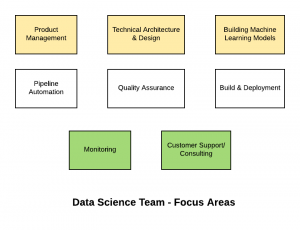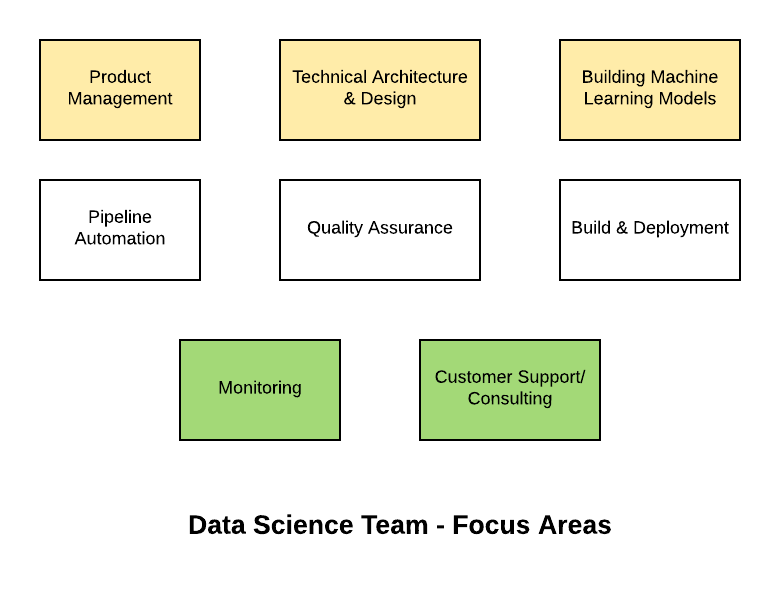
Setting up a successful artificial intelligence (AI) / data science or advanced analytics practice or center of excellence (CoE) is key to success of AI in your organization. In order to setup a successful data science COE, setting up a well-organized data science team with clearly defined roles & responsibilities is the key. Are you planning to set up the AI or data science team in your organization, and hence, looking for some ideas around data science team structure and related roles and responsibilities? In this post, you will learn about some of the following aspects related to the building data science/machine learning team.
- Focus areas
- Roles & responsibilities
Data Science Team – Focus Areas
The following diagram depicts the focus areas for the data science Or machine learning team.

The following are some of the areas which need to be addressed while planning to build a data science/machine learning team.
- Gathering the requirements from customers (internal or external): There are different techniques which are recommended in relation to requirements gathering. You can do design thinking workshop and do user journey mapping to identify problem statements and related opportunities.
- Product requirement description: As part of detailing product requirements, one of the key recommendation is to do prototyping.
- Technical solution architecture/design
- Building machine learning models – models’ training & testing
- Quality assurance – Quality control checks
- Build & deployment of models
- ML Pipeline automation
- Monitoring the models
- Raising incidents in case of issues with model performance
Data Science Team Composition – Roles & Responsibilities
- Consulting staff (Customer facing): This person will be responsible to do some of the following:
- Take the requirements from the customers or identify the requirements (opportunities) based on the discussion with customers.
- Play a key role in performing user-acceptance testing of the solution built with one or more machine learning models.
- Provide training to the customer stakeholders on interpreting the predictive models’ outcome and report appropriately in case of anomalies.
- Product Manager/Business analyst: This person will be responsible for doing some of the following:
- Work with the consulting staff member to fill them up with upcoming releases, get the customers’ feedback, gather the requirements
- Do design thinking workshop and user journey mapping to identify most important user pain points in order to carve out solutions which results in quick wins on one hand while laying down foundation for strategic solutioning.
- Design the prototype including dashboards and get user or customer acceptance.
- Come up with solutions requirements requiring predictive and optimization (prescriptive) models
- Work with data scientists to describe the product requirements, resolve requirements related issues from time-to-time
- Work with product engineering team to integrate machine learning models with product features
- Guide the product and data science team in releasing the solution covering the predictive and optimization models
- Document the product requirement specifications (PRS)
- Data Scientist (Architect): This person would be responsible for the following:
- Work with product manager/business analyst to understand the use case
- Architect the solution related to machine learning model
- Document technical design specifications covering some of the following details:
- Use case description: Break down the problem statement into sub problem and design solutions appropriately. Drivetrain approach or theory of change can be adopted for this analysis.
- Feature analysis
- Data analysis including data gathering, data preparation etc.
- Machine learning algorithms to be used
- Validation/Testing techniques
- Build & deployment steps
- Work with data scientists, data scientist (lead/project manager)
- Identifying areas of research and get the team involved in exploring new methods and techniques related to different aspects of building machine learning models.
- Lay down quality assurance strategies (quality control checks)
- Be involved in hiring and mentoring, scaling the team
- Data Scientist (Lead/Project Manager): This person will have some of the following responsibilities. This person could manage one or more data science teams based on the workload.
- Manage the project execution (tracking), timelines, deliverables
- Manage the team of data scientists
- Get involved in hiring activities
- Data Scientists: Data scientists are the ones who are responsible for the following:
- Analysis/Design of models
- Build machine learning models; Test the models
- Perform quality control checks in relation to ensure quality models
- Enable the release of models into production
- Software Engineer: This person would be needed for making sure software engineering principles are appropriately implemented while building the models. This person should be good at scripting. This person could be dedicated to more than one data science teams.
- Ops Engineer: This person would be responsible for automation related tasks such as ML pipeline automation. Note that ML pipeline automation would include automation of retraining the models, and testing the models. This person should be good at scripting. This person could be dedicated to more than one data science teams.
- Ops Support/Monitoring Staff: This person would be responsible for some of the following tasks. This person would be dedicated to more than one data science teams.
- Get involved with monitoring tasks related to monitoring the models’ performance
- Record the issues and raise the same with incident management system; Idea is to raise alerts for data science team as a whole.
References
Summary
In this post, you learned about the data science team structure/composition in relation to different roles & responsibilities that needed to be performed for building and deploying the models into production. The key focus areas include product requirement elicitation, technical architecture design, building machine learning models, and deploying them into production.
- Coefficient of Variation in Regression Modelling: Example - November 9, 2025
- Chunking Strategies for RAG with Examples - November 2, 2025
- RAG Pipeline: 6 Steps for Creating Naive RAG App - November 1, 2025
I found it very helpful. However the differences are not too understandable for me